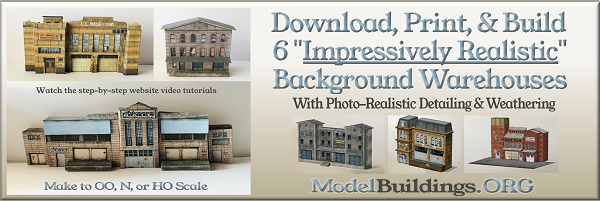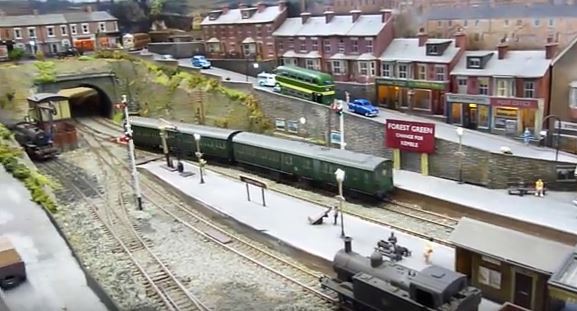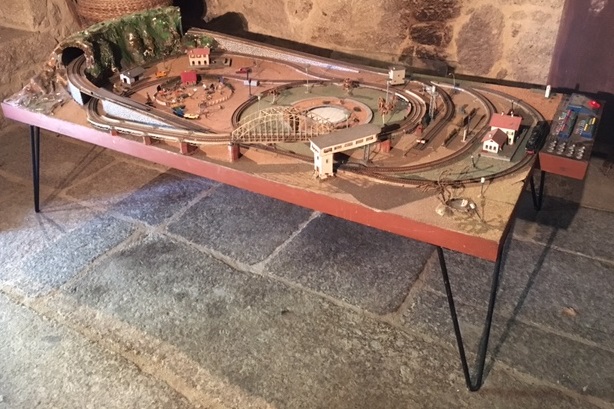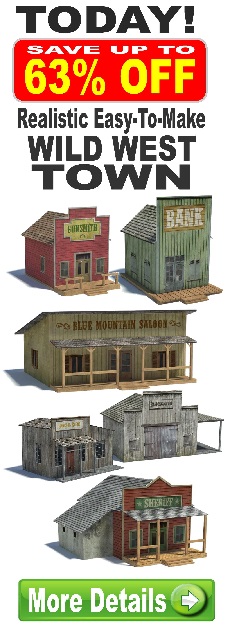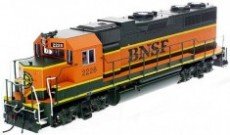Everything on model trains, model railroads, model railways, locomotives, model train layouts, scenery, wiring, DCC and more. Enjoy the world's best hobby... model railroading!
South Bay Historical Railroad Society Layout
The South Bay Historical Railroad Society is located in the historic (built 1863) Santa Clara Depot in Santa Clara, California, USA. Within the Depot is an HO and N scale model railroad layout depicting various railroad eras. The N scale layout in this scene is 11ft wide by 52 ft long with 3 mainlines, and helix’s at both ends to service all 3 lines.
This scene shows the residential area and part of the passenger station (right). The layout looks impressive, but I’m not sure I would like to be in one of those vehicles when that double header diesel roars through the town so close to the road. Looks like an amazing layout.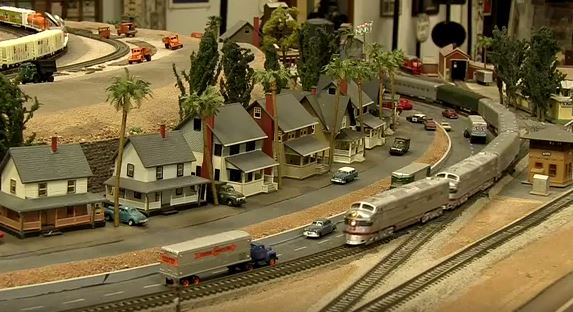
Minimum Turning Circle for Model Trains
Brian asks readers:
“What is the minimum turning circle (OO gauge). I have just had a new shed built it is 3m X 4m unfortunately it door opens inwards. I want to put a layout with the door open but don’t know what the smallest turn that I would need. Any help would be grateful.”
How To Resolve Rusted Track Problems
Dale asks readers:
“I live next to the beach in sunny north Queensland, Australia and have my layout setup in our garage. Temperatures average 28 to 36 degrees Celsius. I have an aircon but like to open the side door if it’s not too hot and let the gentle sea breeze in instead of running aircon. Problem is my track has growing patches of rust. Would this be the humidity or maybe the sea spray in the air? Any suggestions for coping with the rust and stopping it getting out of hand?”
Tiny Integrated Circuit Transceivers
Denis asks readers:
“Hi. I model British N gauge. In recent years there have been a number of tiny Integrated Circuit (IC) Transceiver/MCUs developed. With these small ICs circuit boards could be developed to fit N Gauge or smaller.
Has anyone tried this? Is there plans or software for sale”
Sileby Model Railway Exhibition
Another photo from Damien of the Sileby Model Railway Exhibition in the UK. This is a busy scene some excellent natural weathered effects like the color of the track ballasting. Despite its compact size, the scene has a lot of perspective both height and distance. The low relief buildings add to that effect as does the photo backdrop with more terraced houses.
What’s The Correct Way To Do Railroad Wiring?
Anthony G asks readers:
“I am confused with what wire to use for wiring my track… I will run DCC. Should I use a different gauge for switches, signals, inside structures? What about color coding? I read something about telephone wire – that confused me more. Do I need a different gauge for 12 volt power supply and a different gauge to the track? Any safety issues to watch out for? Can people help coz it’s hard for me to get my head around all this stuff? A lot for me to learn.”
Sealing and Painting Benchwork
Bryan asks readers:
“This is my first layout – HO – I’m working on so I want to try and get most things right. Is there any advantage in me painting all the benchwork including underneath, or is that a waste of time? Do I need to seal my benchwork before I attempt to lay any track or add scenery? I’m not trying to save work, I just want to get things right if I can.”
How Do DCC Decoders Compare?
Roger asks readers:
“Greetings from the Adelaide Hills. South Australia. My club uses the NCE control units. Is it possible for someone to give us a round down on the different DCC Decoders. I know you get what you pay for, however we live in a real world and that means budget restrains.”
60’s Marklin Train Layout Refurbishment
Aurélio asks readers for suggestions:
“I’m trying to refurbish a last 60’s Marklin train, a legacy from an uncle and that at its time, made my cousin’s and my youth quite happy. The layout suffered several “attacks” during all this years, as you can see from the attached photo. I will try to use the base and improve the layout and the details; let’s see if I’m able to do it. Suggestions appreciated.”
Overcoming Derailments
Bill models OO gauge (similar to HO) and asks readers:
“I have a new system put up which runs very well, however now for some reason it’s starting to derail. Different types of locomotives run well for a certain amount of time, then they start derailing for no apparent reason. I am not a novice modeller, but I’m getting fed up with the continual derailment. Sometimes I can find a small problem which I put right, sometimes I find nothing, and I’m STILL getting problems. I have checked the back to back on all the locos and found that some were out and some were ok, which I soon put right with the back to back gauge. I’m thinking of giving the whole thing the heave-ho so if someone could come up with some suggestions, I would be much obliged. Thanks in advance.”
